CO5123 Advanced Accounting: AASB 16 (IFRS) and its Impact on Leases
VerifiedAdded on 2023/06/07
|13
|3077
|448
Essay
AI Summary
This essay explores the impact of AASB 16 (IFRS) on lease accounting, analyzing the reasons for developing new standards and the shortcomings of the previous standard, IAS 17. It discusses how the old standard failed to reflect the economic reality of leases, leading to significant off-balance-she...
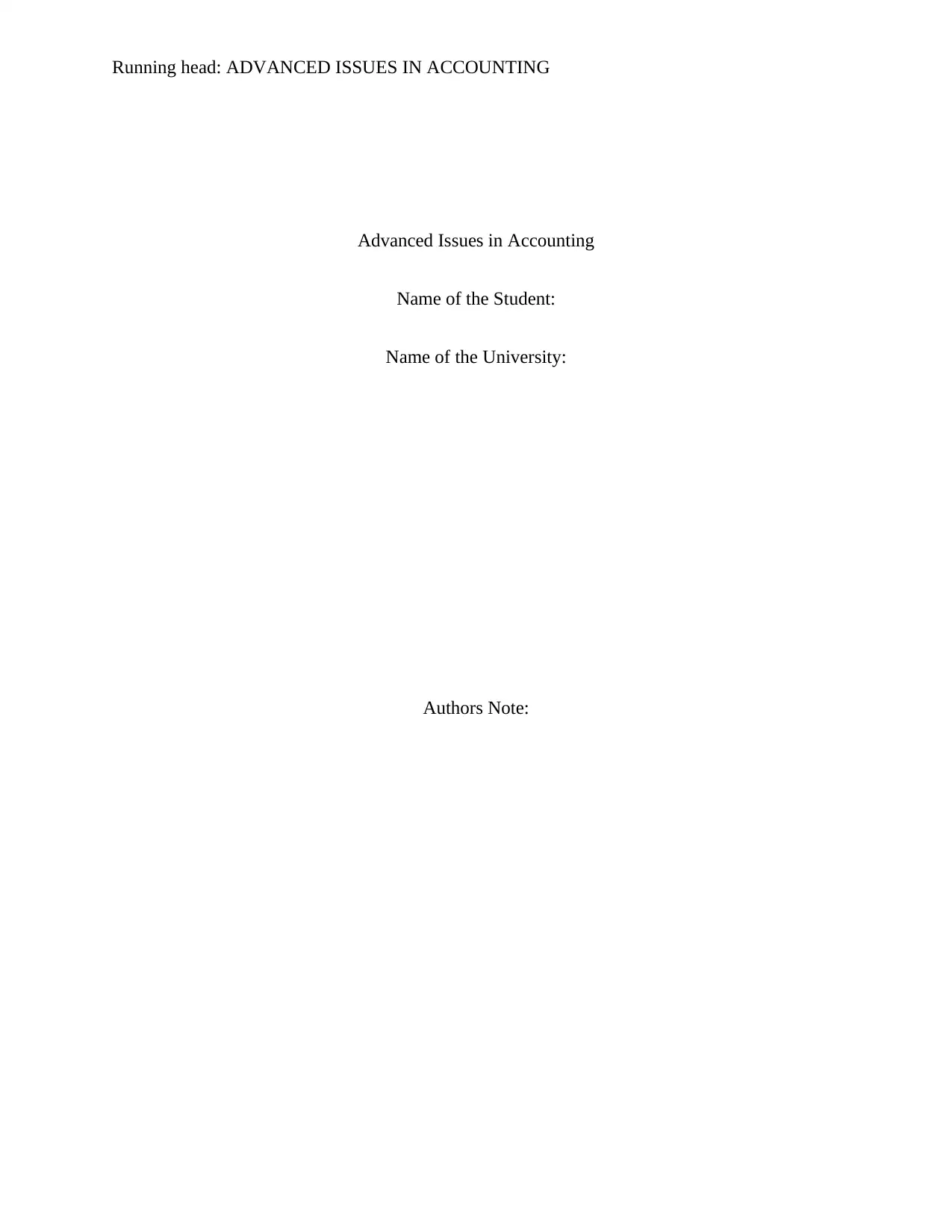
Running head: ADVANCED ISSUES IN ACCOUNTING
Advanced Issues in Accounting
Name of the Student:
Name of the University:
Authors Note:
Advanced Issues in Accounting
Name of the Student:
Name of the University:
Authors Note:
Paraphrase This Document
Need a fresh take? Get an instant paraphrase of this document with our AI Paraphraser
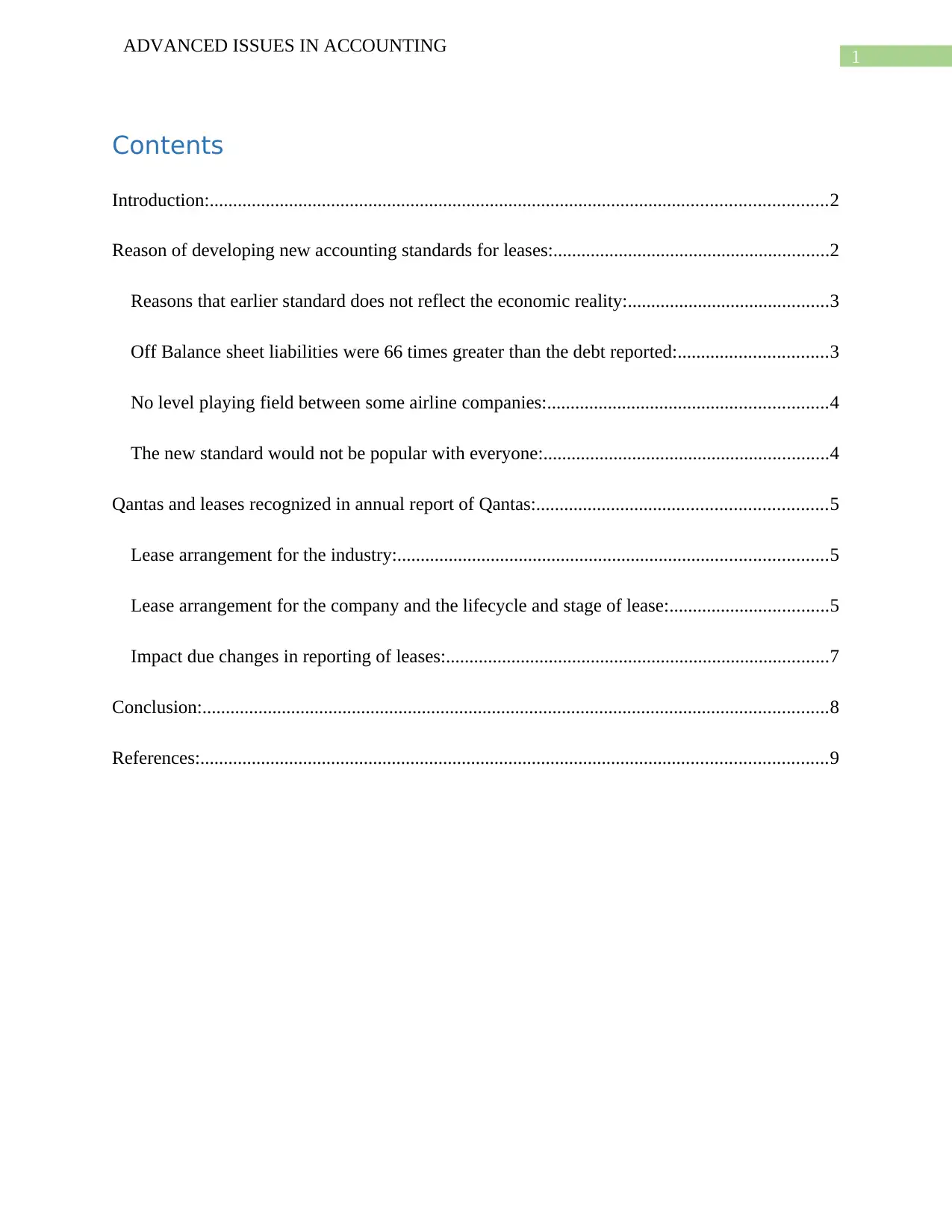
1
ADVANCED ISSUES IN ACCOUNTING
Contents
Introduction:....................................................................................................................................2
Reason of developing new accounting standards for leases:...........................................................2
Reasons that earlier standard does not reflect the economic reality:...........................................3
Off Balance sheet liabilities were 66 times greater than the debt reported:................................3
No level playing field between some airline companies:............................................................4
The new standard would not be popular with everyone:.............................................................4
Qantas and leases recognized in annual report of Qantas:..............................................................5
Lease arrangement for the industry:............................................................................................5
Lease arrangement for the company and the lifecycle and stage of lease:..................................5
Impact due changes in reporting of leases:..................................................................................7
Conclusion:......................................................................................................................................8
References:......................................................................................................................................9
ADVANCED ISSUES IN ACCOUNTING
Contents
Introduction:....................................................................................................................................2
Reason of developing new accounting standards for leases:...........................................................2
Reasons that earlier standard does not reflect the economic reality:...........................................3
Off Balance sheet liabilities were 66 times greater than the debt reported:................................3
No level playing field between some airline companies:............................................................4
The new standard would not be popular with everyone:.............................................................4
Qantas and leases recognized in annual report of Qantas:..............................................................5
Lease arrangement for the industry:............................................................................................5
Lease arrangement for the company and the lifecycle and stage of lease:..................................5
Impact due changes in reporting of leases:..................................................................................7
Conclusion:......................................................................................................................................8
References:......................................................................................................................................9
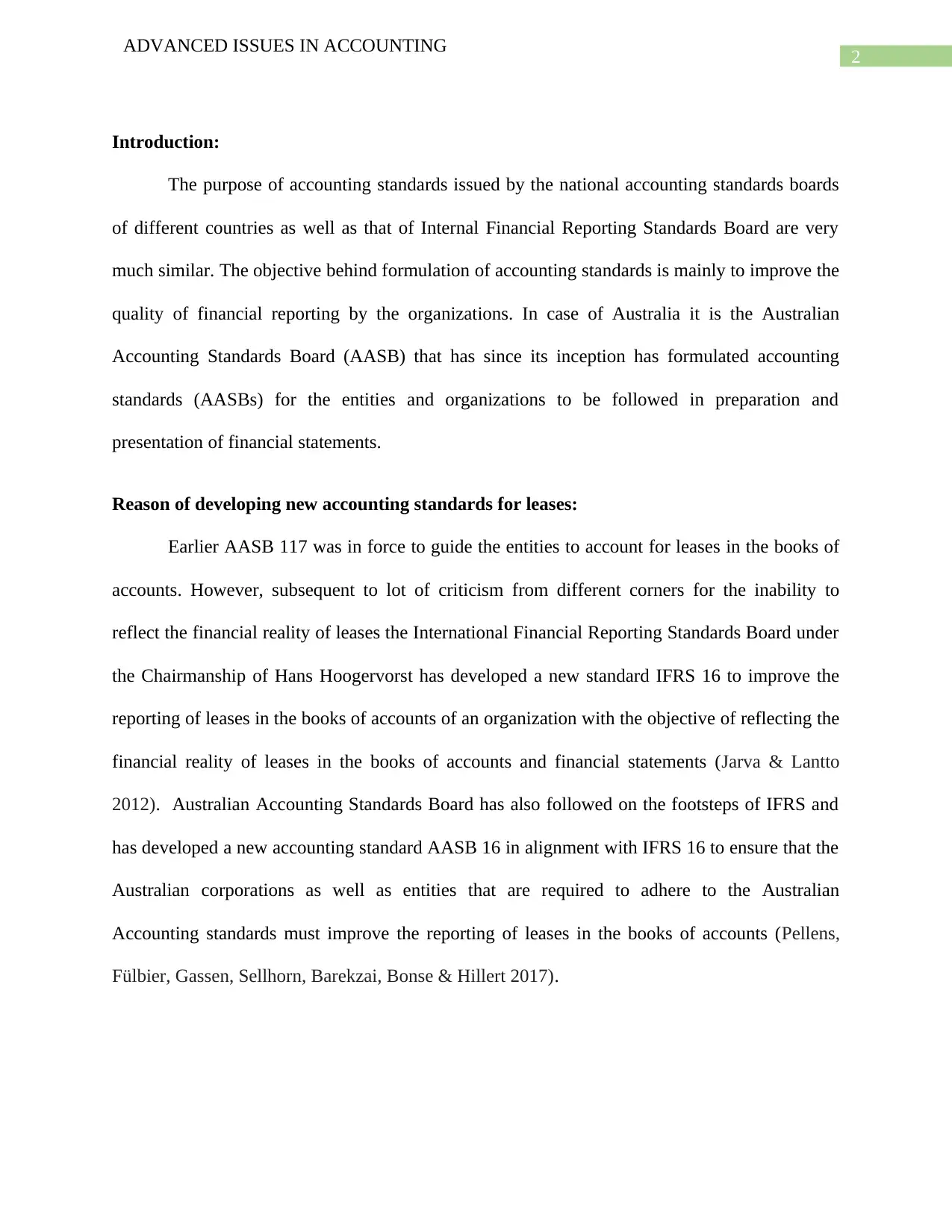
2
ADVANCED ISSUES IN ACCOUNTING
Introduction:
The purpose of accounting standards issued by the national accounting standards boards
of different countries as well as that of Internal Financial Reporting Standards Board are very
much similar. The objective behind formulation of accounting standards is mainly to improve the
quality of financial reporting by the organizations. In case of Australia it is the Australian
Accounting Standards Board (AASB) that has since its inception has formulated accounting
standards (AASBs) for the entities and organizations to be followed in preparation and
presentation of financial statements.
Reason of developing new accounting standards for leases:
Earlier AASB 117 was in force to guide the entities to account for leases in the books of
accounts. However, subsequent to lot of criticism from different corners for the inability to
reflect the financial reality of leases the International Financial Reporting Standards Board under
the Chairmanship of Hans Hoogervorst has developed a new standard IFRS 16 to improve the
reporting of leases in the books of accounts of an organization with the objective of reflecting the
financial reality of leases in the books of accounts and financial statements (Jarva & Lantto
2012). Australian Accounting Standards Board has also followed on the footsteps of IFRS and
has developed a new accounting standard AASB 16 in alignment with IFRS 16 to ensure that the
Australian corporations as well as entities that are required to adhere to the Australian
Accounting standards must improve the reporting of leases in the books of accounts (Pellens,
Fülbier, Gassen, Sellhorn, Barekzai, Bonse & Hillert 2017).
ADVANCED ISSUES IN ACCOUNTING
Introduction:
The purpose of accounting standards issued by the national accounting standards boards
of different countries as well as that of Internal Financial Reporting Standards Board are very
much similar. The objective behind formulation of accounting standards is mainly to improve the
quality of financial reporting by the organizations. In case of Australia it is the Australian
Accounting Standards Board (AASB) that has since its inception has formulated accounting
standards (AASBs) for the entities and organizations to be followed in preparation and
presentation of financial statements.
Reason of developing new accounting standards for leases:
Earlier AASB 117 was in force to guide the entities to account for leases in the books of
accounts. However, subsequent to lot of criticism from different corners for the inability to
reflect the financial reality of leases the International Financial Reporting Standards Board under
the Chairmanship of Hans Hoogervorst has developed a new standard IFRS 16 to improve the
reporting of leases in the books of accounts of an organization with the objective of reflecting the
financial reality of leases in the books of accounts and financial statements (Jarva & Lantto
2012). Australian Accounting Standards Board has also followed on the footsteps of IFRS and
has developed a new accounting standard AASB 16 in alignment with IFRS 16 to ensure that the
Australian corporations as well as entities that are required to adhere to the Australian
Accounting standards must improve the reporting of leases in the books of accounts (Pellens,
Fülbier, Gassen, Sellhorn, Barekzai, Bonse & Hillert 2017).
⊘ This is a preview!⊘
Do you want full access?
Subscribe today to unlock all pages.

Trusted by 1+ million students worldwide
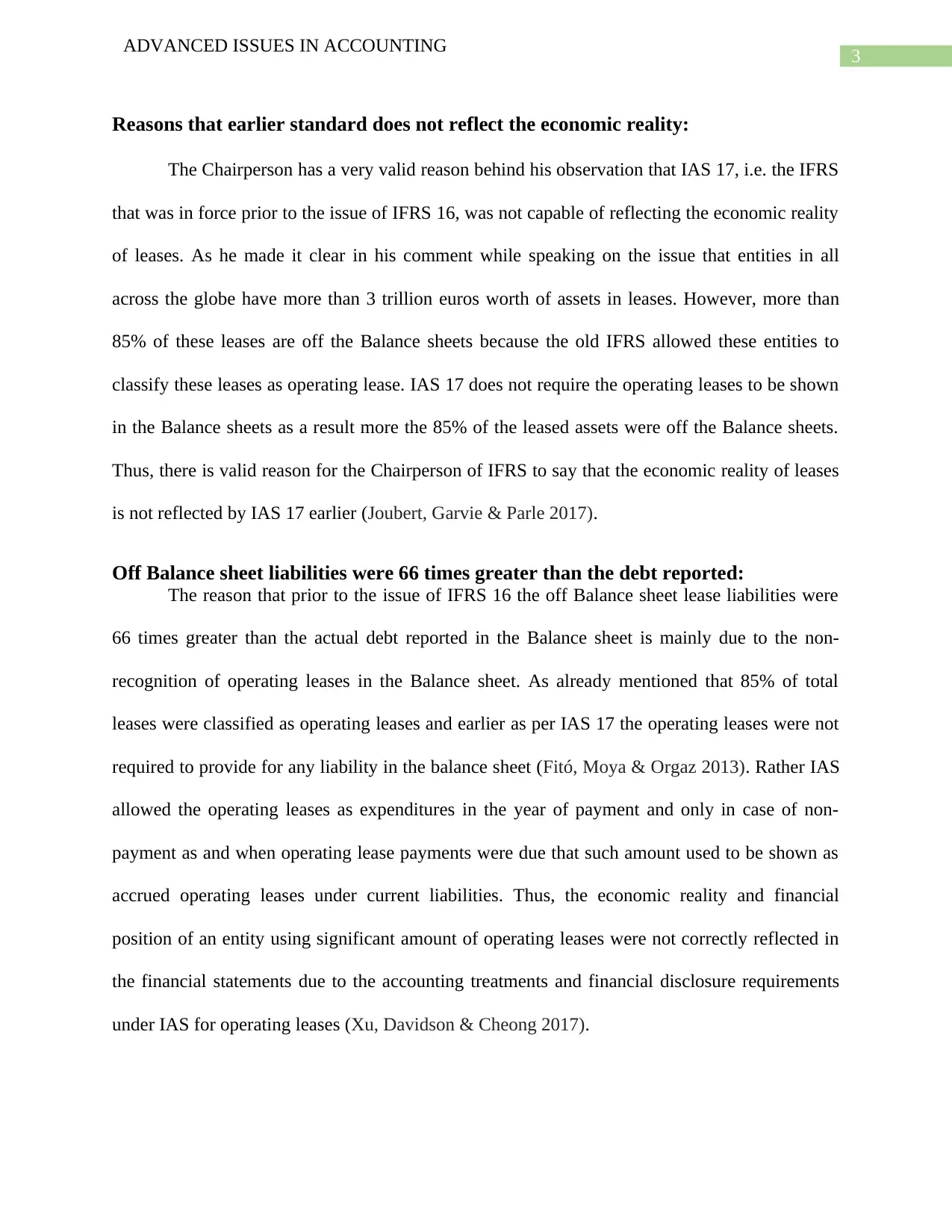
3
ADVANCED ISSUES IN ACCOUNTING
Reasons that earlier standard does not reflect the economic reality:
The Chairperson has a very valid reason behind his observation that IAS 17, i.e. the IFRS
that was in force prior to the issue of IFRS 16, was not capable of reflecting the economic reality
of leases. As he made it clear in his comment while speaking on the issue that entities in all
across the globe have more than 3 trillion euros worth of assets in leases. However, more than
85% of these leases are off the Balance sheets because the old IFRS allowed these entities to
classify these leases as operating lease. IAS 17 does not require the operating leases to be shown
in the Balance sheets as a result more the 85% of the leased assets were off the Balance sheets.
Thus, there is valid reason for the Chairperson of IFRS to say that the economic reality of leases
is not reflected by IAS 17 earlier (Joubert, Garvie & Parle 2017).
Off Balance sheet liabilities were 66 times greater than the debt reported:
The reason that prior to the issue of IFRS 16 the off Balance sheet lease liabilities were
66 times greater than the actual debt reported in the Balance sheet is mainly due to the non-
recognition of operating leases in the Balance sheet. As already mentioned that 85% of total
leases were classified as operating leases and earlier as per IAS 17 the operating leases were not
required to provide for any liability in the balance sheet (Fitó, Moya & Orgaz 2013). Rather IAS
allowed the operating leases as expenditures in the year of payment and only in case of non-
payment as and when operating lease payments were due that such amount used to be shown as
accrued operating leases under current liabilities. Thus, the economic reality and financial
position of an entity using significant amount of operating leases were not correctly reflected in
the financial statements due to the accounting treatments and financial disclosure requirements
under IAS for operating leases (Xu, Davidson & Cheong 2017).
ADVANCED ISSUES IN ACCOUNTING
Reasons that earlier standard does not reflect the economic reality:
The Chairperson has a very valid reason behind his observation that IAS 17, i.e. the IFRS
that was in force prior to the issue of IFRS 16, was not capable of reflecting the economic reality
of leases. As he made it clear in his comment while speaking on the issue that entities in all
across the globe have more than 3 trillion euros worth of assets in leases. However, more than
85% of these leases are off the Balance sheets because the old IFRS allowed these entities to
classify these leases as operating lease. IAS 17 does not require the operating leases to be shown
in the Balance sheets as a result more the 85% of the leased assets were off the Balance sheets.
Thus, there is valid reason for the Chairperson of IFRS to say that the economic reality of leases
is not reflected by IAS 17 earlier (Joubert, Garvie & Parle 2017).
Off Balance sheet liabilities were 66 times greater than the debt reported:
The reason that prior to the issue of IFRS 16 the off Balance sheet lease liabilities were
66 times greater than the actual debt reported in the Balance sheet is mainly due to the non-
recognition of operating leases in the Balance sheet. As already mentioned that 85% of total
leases were classified as operating leases and earlier as per IAS 17 the operating leases were not
required to provide for any liability in the balance sheet (Fitó, Moya & Orgaz 2013). Rather IAS
allowed the operating leases as expenditures in the year of payment and only in case of non-
payment as and when operating lease payments were due that such amount used to be shown as
accrued operating leases under current liabilities. Thus, the economic reality and financial
position of an entity using significant amount of operating leases were not correctly reflected in
the financial statements due to the accounting treatments and financial disclosure requirements
under IAS for operating leases (Xu, Davidson & Cheong 2017).
Paraphrase This Document
Need a fresh take? Get an instant paraphrase of this document with our AI Paraphraser

4
ADVANCED ISSUES IN ACCOUNTING
No level playing field between some airline companies:
The chairperson of IFRS correctly argued that there was no level playing field between
some airline companies due to the ineffective accounting treatment and financial disclosure
requirements under IAS 17. As per the former standard on leases an entity was not required to
show the expected amount of liabilities for large number of aeroplanes and other equipment
taken on lease if these were classified as operating leases. As soon as an airline company
classified the leases as operating leases it was not required to include the equipment and flights
in the Balance sheet and the liabilities in respect of these equipment and flights were also off the
Balance sheet. Thus, for airline companies that have classified most of its leases as financial
leases will have completely different looking Balance sheet as compared to those that have
classified most of its leases as operating leases. Thus, there would be no level playing field
between the airline companies with significant financial leases and airline companies with not so
significant amount of financial leases (Abbott & Tan‐Kantor 2018).
The new standard would not be popular with everyone:
The new accounting standards, i.e. IFRS 16 for international entities and AASB 16 for
Australian entities, will not be popular with everyone as IFRS 16 and corresponding Australian
accounting standard AASB 16 require the entities to show both financial and operating leases in
the Balance sheet to reflect the economic and financial reality of leased assets and liabilities in
respect of these leases. As a result of the accounting treatment and disclosure requirements for
operating and financial leases in the financial statements the large entities with significant
amount of operating leases would have to report all of its operating leases in Balance sheet. As a
result of this the debt and liability position of such entities would reflect the actual economic
reality of these entities thus, the rosy pictures that were being painted under IAS 17 would not be
ADVANCED ISSUES IN ACCOUNTING
No level playing field between some airline companies:
The chairperson of IFRS correctly argued that there was no level playing field between
some airline companies due to the ineffective accounting treatment and financial disclosure
requirements under IAS 17. As per the former standard on leases an entity was not required to
show the expected amount of liabilities for large number of aeroplanes and other equipment
taken on lease if these were classified as operating leases. As soon as an airline company
classified the leases as operating leases it was not required to include the equipment and flights
in the Balance sheet and the liabilities in respect of these equipment and flights were also off the
Balance sheet. Thus, for airline companies that have classified most of its leases as financial
leases will have completely different looking Balance sheet as compared to those that have
classified most of its leases as operating leases. Thus, there would be no level playing field
between the airline companies with significant financial leases and airline companies with not so
significant amount of financial leases (Abbott & Tan‐Kantor 2018).
The new standard would not be popular with everyone:
The new accounting standards, i.e. IFRS 16 for international entities and AASB 16 for
Australian entities, will not be popular with everyone as IFRS 16 and corresponding Australian
accounting standard AASB 16 require the entities to show both financial and operating leases in
the Balance sheet to reflect the economic and financial reality of leased assets and liabilities in
respect of these leases. As a result of the accounting treatment and disclosure requirements for
operating and financial leases in the financial statements the large entities with significant
amount of operating leases would have to report all of its operating leases in Balance sheet. As a
result of this the debt and liability position of such entities would reflect the actual economic
reality of these entities thus, the rosy pictures that were being painted under IAS 17 would not be

5
ADVANCED ISSUES IN ACCOUNTING
possible. Thus, the new accounting standard IFRS 16 would not be popular with such entities
that have significant amount of operating leases in its books of accounts (Firth & Gounopoulos
2017).
Qantas and leases recognized in annual report of Qantas:
The annual report 2018 of Qantas contains the complete set of financial statements. An
evaluation shall be conducted on the annual report of the company and specifically that of its
financial statements to assess how leases have been classified and reported in the financial
statements. The appraisal of leasing arrangements made by the company shall be made taking
into consideration the detailed discussion that has been made on IFRS 16 and AASB 16 earlier in
this document.
Lease arrangement for the industry:
Qantas operating in Airline industry however, is not an exception to the practice of not
reporting huge amount of operating leases in the Balance sheet as the practice is very much
widespread in the industry. However, with the introduction of IFRS 16 it is expected that the
economic reality of operating leases would not be concealed from the users of financial
statements as the standard makes it compulsory for the entities to report such operating leases
also along with financial leases (Edeigba & Amenkhienan 2017).
Lease arrangement for the company and the lifecycle and stage of lease:
For the financial year ending on June 30, 2018 the company has reported its leases as per
the requirements of IFRS 16 as it did even for the previous year ending on 30th June, 2017
(Backof, Bamber & Carpenter 2016).
ADVANCED ISSUES IN ACCOUNTING
possible. Thus, the new accounting standard IFRS 16 would not be popular with such entities
that have significant amount of operating leases in its books of accounts (Firth & Gounopoulos
2017).
Qantas and leases recognized in annual report of Qantas:
The annual report 2018 of Qantas contains the complete set of financial statements. An
evaluation shall be conducted on the annual report of the company and specifically that of its
financial statements to assess how leases have been classified and reported in the financial
statements. The appraisal of leasing arrangements made by the company shall be made taking
into consideration the detailed discussion that has been made on IFRS 16 and AASB 16 earlier in
this document.
Lease arrangement for the industry:
Qantas operating in Airline industry however, is not an exception to the practice of not
reporting huge amount of operating leases in the Balance sheet as the practice is very much
widespread in the industry. However, with the introduction of IFRS 16 it is expected that the
economic reality of operating leases would not be concealed from the users of financial
statements as the standard makes it compulsory for the entities to report such operating leases
also along with financial leases (Edeigba & Amenkhienan 2017).
Lease arrangement for the company and the lifecycle and stage of lease:
For the financial year ending on June 30, 2018 the company has reported its leases as per
the requirements of IFRS 16 as it did even for the previous year ending on 30th June, 2017
(Backof, Bamber & Carpenter 2016).
⊘ This is a preview!⊘
Do you want full access?
Subscribe today to unlock all pages.

Trusted by 1+ million students worldwide
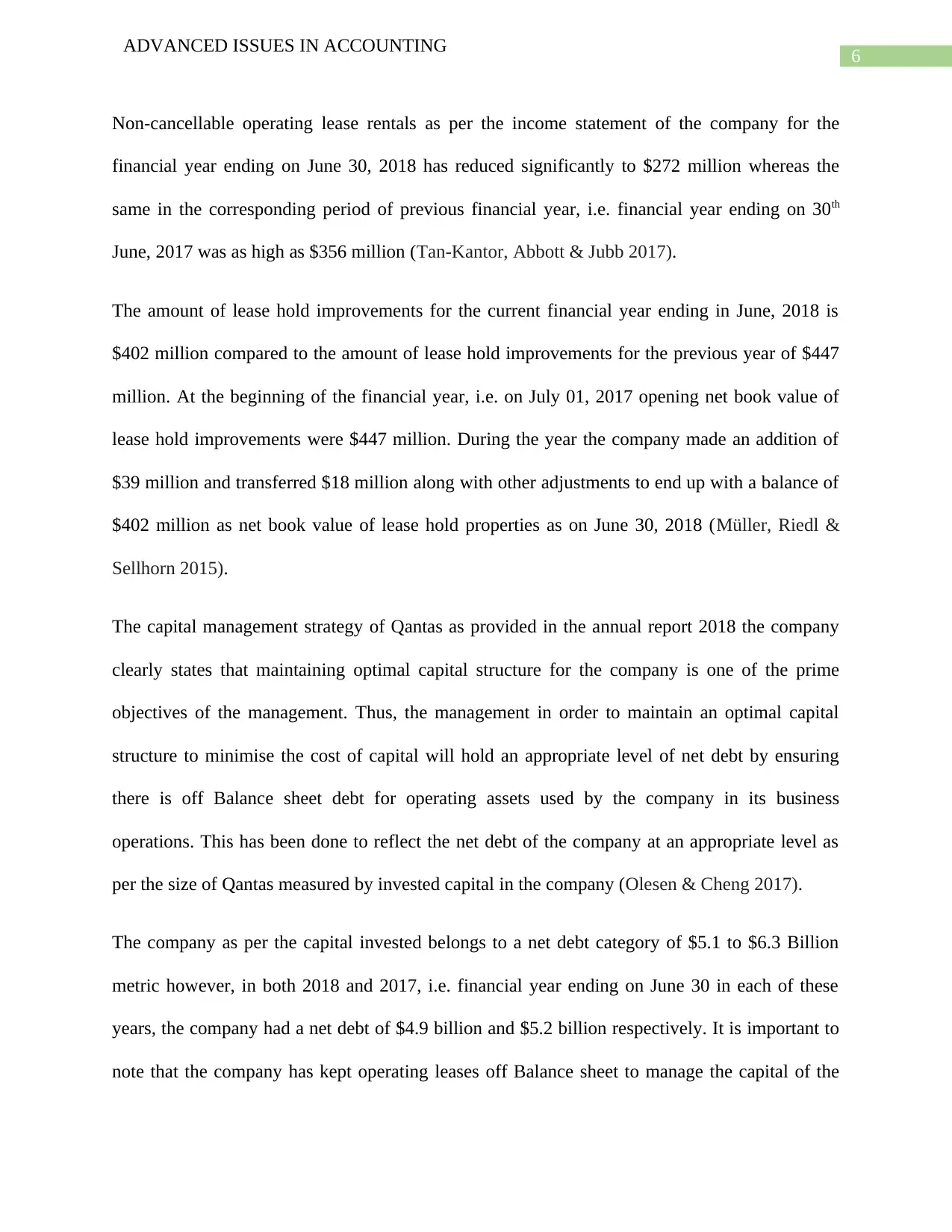
6
ADVANCED ISSUES IN ACCOUNTING
Non-cancellable operating lease rentals as per the income statement of the company for the
financial year ending on June 30, 2018 has reduced significantly to $272 million whereas the
same in the corresponding period of previous financial year, i.e. financial year ending on 30th
June, 2017 was as high as $356 million (Tan‐Kantor, Abbott & Jubb 2017).
The amount of lease hold improvements for the current financial year ending in June, 2018 is
$402 million compared to the amount of lease hold improvements for the previous year of $447
million. At the beginning of the financial year, i.e. on July 01, 2017 opening net book value of
lease hold improvements were $447 million. During the year the company made an addition of
$39 million and transferred $18 million along with other adjustments to end up with a balance of
$402 million as net book value of lease hold properties as on June 30, 2018 (Müller, Riedl &
Sellhorn 2015).
The capital management strategy of Qantas as provided in the annual report 2018 the company
clearly states that maintaining optimal capital structure for the company is one of the prime
objectives of the management. Thus, the management in order to maintain an optimal capital
structure to minimise the cost of capital will hold an appropriate level of net debt by ensuring
there is off Balance sheet debt for operating assets used by the company in its business
operations. This has been done to reflect the net debt of the company at an appropriate level as
per the size of Qantas measured by invested capital in the company (Olesen & Cheng 2017).
The company as per the capital invested belongs to a net debt category of $5.1 to $6.3 Billion
metric however, in both 2018 and 2017, i.e. financial year ending on June 30 in each of these
years, the company had a net debt of $4.9 billion and $5.2 billion respectively. It is important to
note that the company has kept operating leases off Balance sheet to manage the capital of the
ADVANCED ISSUES IN ACCOUNTING
Non-cancellable operating lease rentals as per the income statement of the company for the
financial year ending on June 30, 2018 has reduced significantly to $272 million whereas the
same in the corresponding period of previous financial year, i.e. financial year ending on 30th
June, 2017 was as high as $356 million (Tan‐Kantor, Abbott & Jubb 2017).
The amount of lease hold improvements for the current financial year ending in June, 2018 is
$402 million compared to the amount of lease hold improvements for the previous year of $447
million. At the beginning of the financial year, i.e. on July 01, 2017 opening net book value of
lease hold improvements were $447 million. During the year the company made an addition of
$39 million and transferred $18 million along with other adjustments to end up with a balance of
$402 million as net book value of lease hold properties as on June 30, 2018 (Müller, Riedl &
Sellhorn 2015).
The capital management strategy of Qantas as provided in the annual report 2018 the company
clearly states that maintaining optimal capital structure for the company is one of the prime
objectives of the management. Thus, the management in order to maintain an optimal capital
structure to minimise the cost of capital will hold an appropriate level of net debt by ensuring
there is off Balance sheet debt for operating assets used by the company in its business
operations. This has been done to reflect the net debt of the company at an appropriate level as
per the size of Qantas measured by invested capital in the company (Olesen & Cheng 2017).
The company as per the capital invested belongs to a net debt category of $5.1 to $6.3 Billion
metric however, in both 2018 and 2017, i.e. financial year ending on June 30 in each of these
years, the company had a net debt of $4.9 billion and $5.2 billion respectively. It is important to
note that the company has kept operating leases off Balance sheet to manage the capital of the
Paraphrase This Document
Need a fresh take? Get an instant paraphrase of this document with our AI Paraphraser
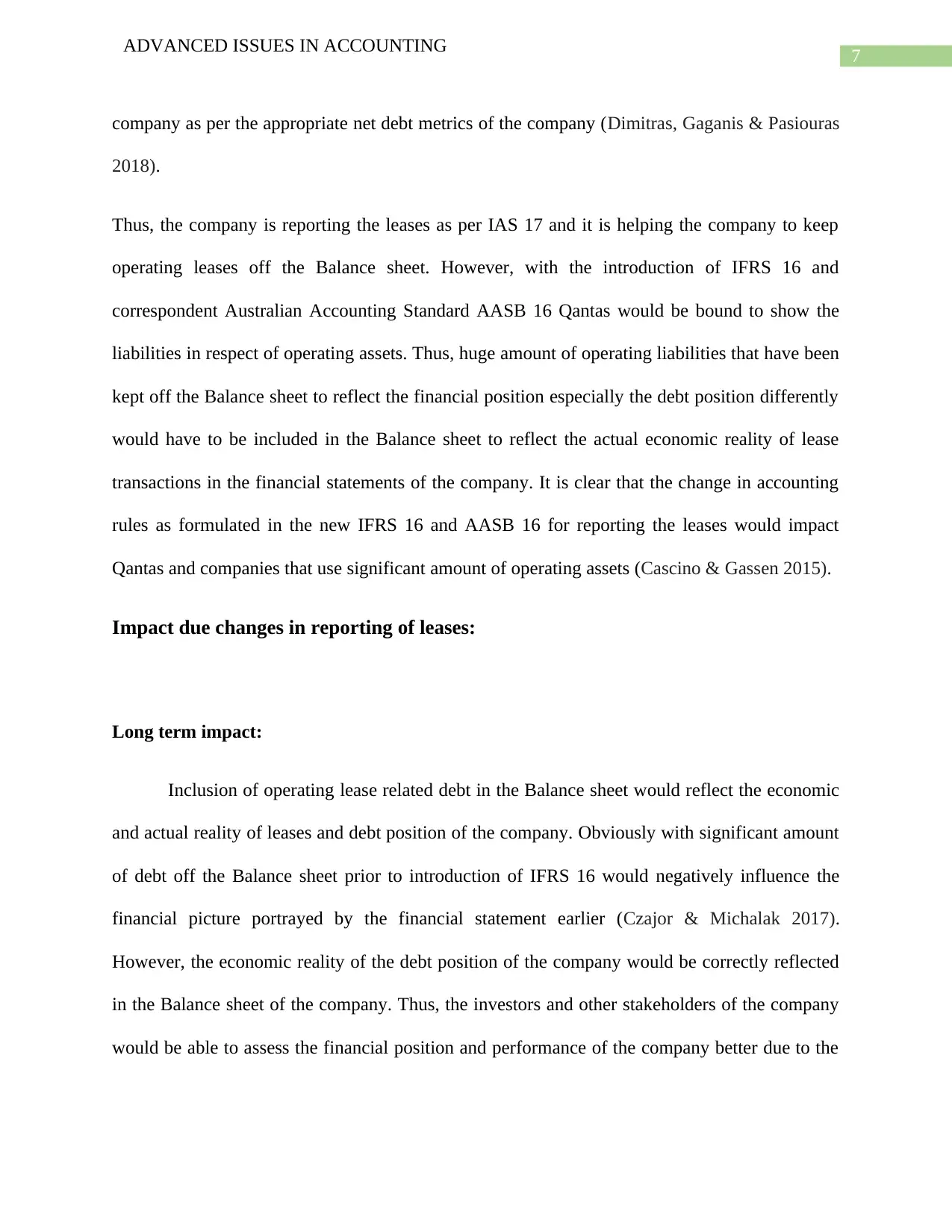
7
ADVANCED ISSUES IN ACCOUNTING
company as per the appropriate net debt metrics of the company (Dimitras, Gaganis & Pasiouras
2018).
Thus, the company is reporting the leases as per IAS 17 and it is helping the company to keep
operating leases off the Balance sheet. However, with the introduction of IFRS 16 and
correspondent Australian Accounting Standard AASB 16 Qantas would be bound to show the
liabilities in respect of operating assets. Thus, huge amount of operating liabilities that have been
kept off the Balance sheet to reflect the financial position especially the debt position differently
would have to be included in the Balance sheet to reflect the actual economic reality of lease
transactions in the financial statements of the company. It is clear that the change in accounting
rules as formulated in the new IFRS 16 and AASB 16 for reporting the leases would impact
Qantas and companies that use significant amount of operating assets (Cascino & Gassen 2015).
Impact due changes in reporting of leases:
Long term impact:
Inclusion of operating lease related debt in the Balance sheet would reflect the economic
and actual reality of leases and debt position of the company. Obviously with significant amount
of debt off the Balance sheet prior to introduction of IFRS 16 would negatively influence the
financial picture portrayed by the financial statement earlier (Czajor & Michalak 2017).
However, the economic reality of the debt position of the company would be correctly reflected
in the Balance sheet of the company. Thus, the investors and other stakeholders of the company
would be able to assess the financial position and performance of the company better due to the
ADVANCED ISSUES IN ACCOUNTING
company as per the appropriate net debt metrics of the company (Dimitras, Gaganis & Pasiouras
2018).
Thus, the company is reporting the leases as per IAS 17 and it is helping the company to keep
operating leases off the Balance sheet. However, with the introduction of IFRS 16 and
correspondent Australian Accounting Standard AASB 16 Qantas would be bound to show the
liabilities in respect of operating assets. Thus, huge amount of operating liabilities that have been
kept off the Balance sheet to reflect the financial position especially the debt position differently
would have to be included in the Balance sheet to reflect the actual economic reality of lease
transactions in the financial statements of the company. It is clear that the change in accounting
rules as formulated in the new IFRS 16 and AASB 16 for reporting the leases would impact
Qantas and companies that use significant amount of operating assets (Cascino & Gassen 2015).
Impact due changes in reporting of leases:
Long term impact:
Inclusion of operating lease related debt in the Balance sheet would reflect the economic
and actual reality of leases and debt position of the company. Obviously with significant amount
of debt off the Balance sheet prior to introduction of IFRS 16 would negatively influence the
financial picture portrayed by the financial statement earlier (Czajor & Michalak 2017).
However, the economic reality of the debt position of the company would be correctly reflected
in the Balance sheet of the company. Thus, the investors and other stakeholders of the company
would be able to assess the financial position and performance of the company better due to the
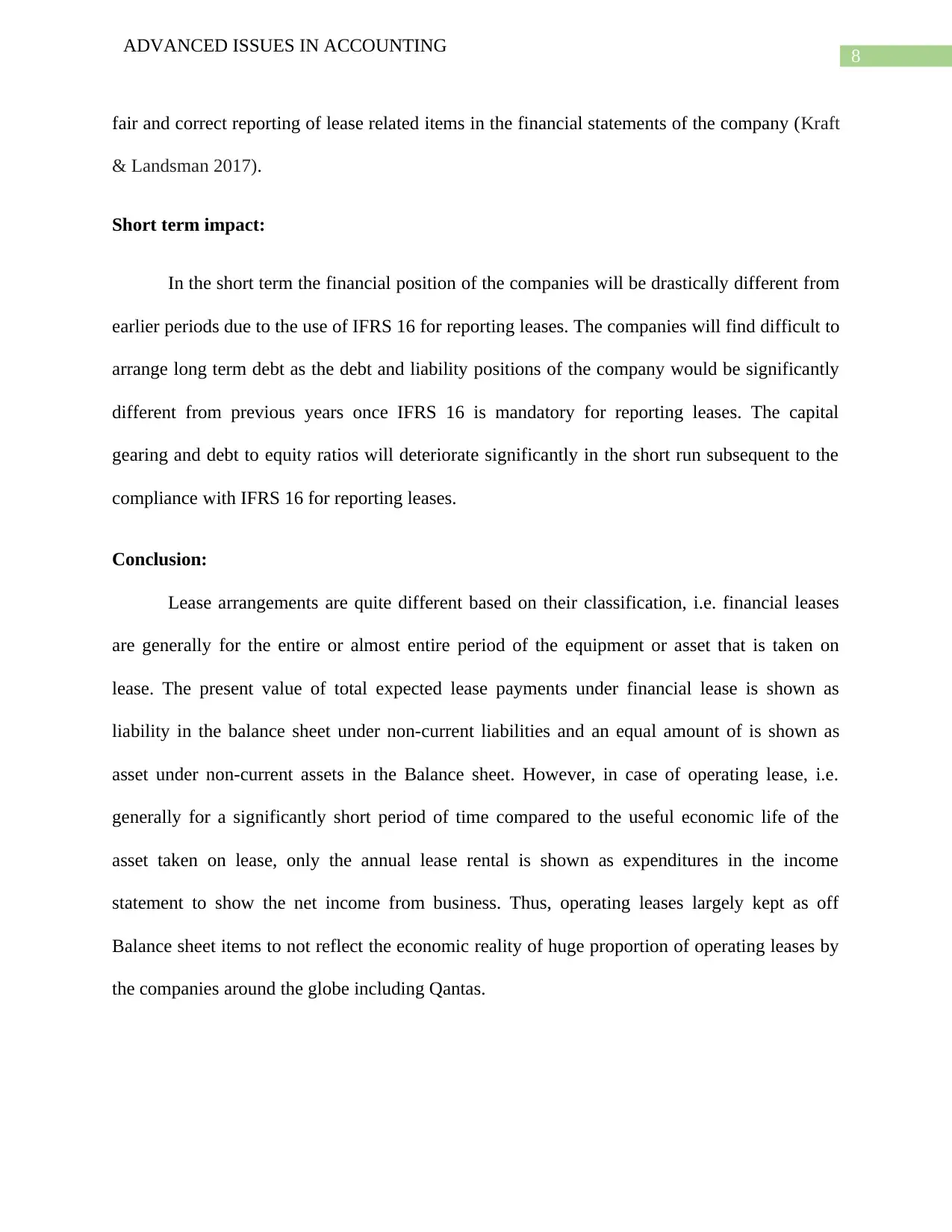
8
ADVANCED ISSUES IN ACCOUNTING
fair and correct reporting of lease related items in the financial statements of the company (Kraft
& Landsman 2017).
Short term impact:
In the short term the financial position of the companies will be drastically different from
earlier periods due to the use of IFRS 16 for reporting leases. The companies will find difficult to
arrange long term debt as the debt and liability positions of the company would be significantly
different from previous years once IFRS 16 is mandatory for reporting leases. The capital
gearing and debt to equity ratios will deteriorate significantly in the short run subsequent to the
compliance with IFRS 16 for reporting leases.
Conclusion:
Lease arrangements are quite different based on their classification, i.e. financial leases
are generally for the entire or almost entire period of the equipment or asset that is taken on
lease. The present value of total expected lease payments under financial lease is shown as
liability in the balance sheet under non-current liabilities and an equal amount of is shown as
asset under non-current assets in the Balance sheet. However, in case of operating lease, i.e.
generally for a significantly short period of time compared to the useful economic life of the
asset taken on lease, only the annual lease rental is shown as expenditures in the income
statement to show the net income from business. Thus, operating leases largely kept as off
Balance sheet items to not reflect the economic reality of huge proportion of operating leases by
the companies around the globe including Qantas.
ADVANCED ISSUES IN ACCOUNTING
fair and correct reporting of lease related items in the financial statements of the company (Kraft
& Landsman 2017).
Short term impact:
In the short term the financial position of the companies will be drastically different from
earlier periods due to the use of IFRS 16 for reporting leases. The companies will find difficult to
arrange long term debt as the debt and liability positions of the company would be significantly
different from previous years once IFRS 16 is mandatory for reporting leases. The capital
gearing and debt to equity ratios will deteriorate significantly in the short run subsequent to the
compliance with IFRS 16 for reporting leases.
Conclusion:
Lease arrangements are quite different based on their classification, i.e. financial leases
are generally for the entire or almost entire period of the equipment or asset that is taken on
lease. The present value of total expected lease payments under financial lease is shown as
liability in the balance sheet under non-current liabilities and an equal amount of is shown as
asset under non-current assets in the Balance sheet. However, in case of operating lease, i.e.
generally for a significantly short period of time compared to the useful economic life of the
asset taken on lease, only the annual lease rental is shown as expenditures in the income
statement to show the net income from business. Thus, operating leases largely kept as off
Balance sheet items to not reflect the economic reality of huge proportion of operating leases by
the companies around the globe including Qantas.
⊘ This is a preview!⊘
Do you want full access?
Subscribe today to unlock all pages.

Trusted by 1+ million students worldwide

9
ADVANCED ISSUES IN ACCOUNTING
ADVANCED ISSUES IN ACCOUNTING
Paraphrase This Document
Need a fresh take? Get an instant paraphrase of this document with our AI Paraphraser
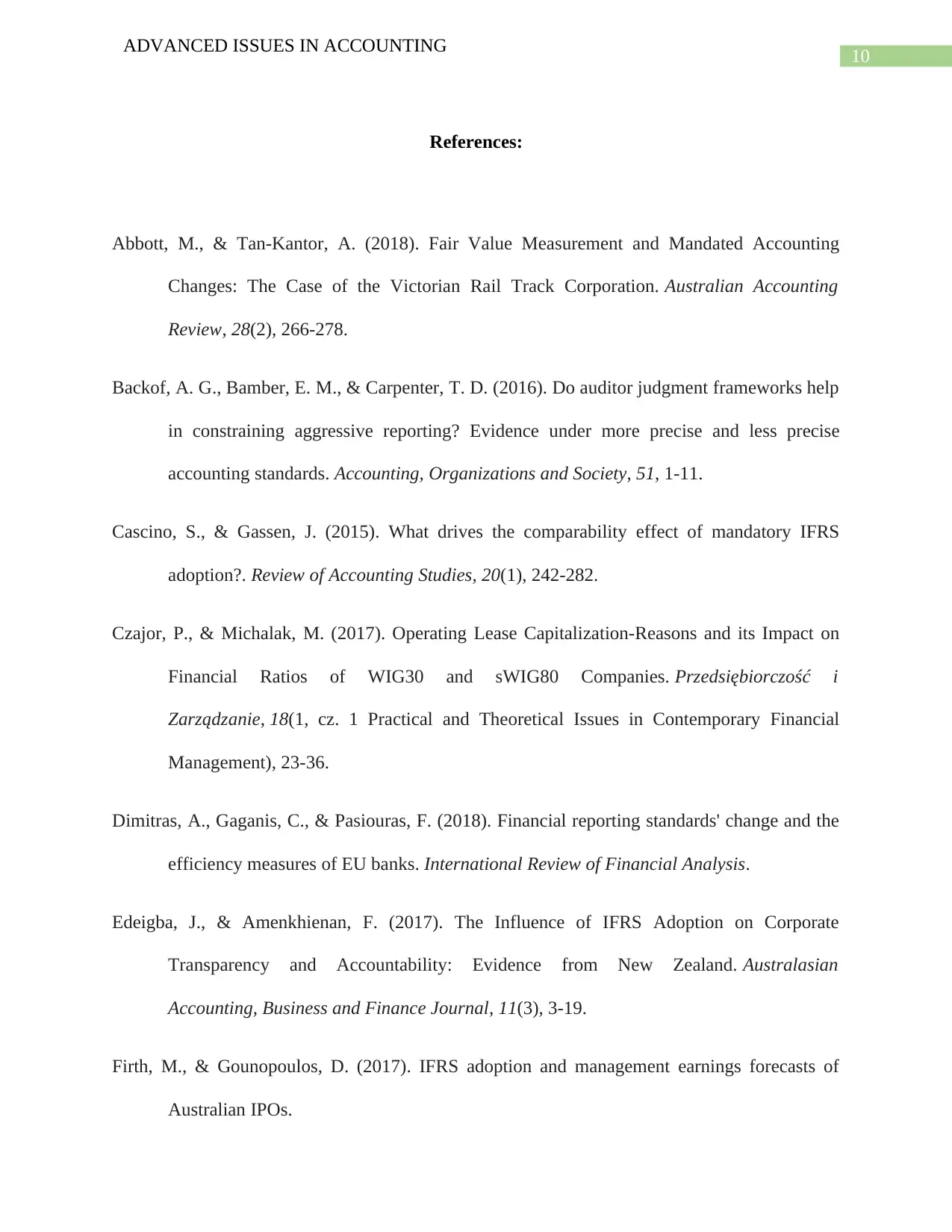
10
ADVANCED ISSUES IN ACCOUNTING
References:
Abbott, M., & Tan‐Kantor, A. (2018). Fair Value Measurement and Mandated Accounting
Changes: The Case of the Victorian Rail Track Corporation. Australian Accounting
Review, 28(2), 266-278.
Backof, A. G., Bamber, E. M., & Carpenter, T. D. (2016). Do auditor judgment frameworks help
in constraining aggressive reporting? Evidence under more precise and less precise
accounting standards. Accounting, Organizations and Society, 51, 1-11.
Cascino, S., & Gassen, J. (2015). What drives the comparability effect of mandatory IFRS
adoption?. Review of Accounting Studies, 20(1), 242-282.
Czajor, P., & Michalak, M. (2017). Operating Lease Capitalization-Reasons and its Impact on
Financial Ratios of WIG30 and sWIG80 Companies. Przedsiębiorczość i
Zarządzanie, 18(1, cz. 1 Practical and Theoretical Issues in Contemporary Financial
Management), 23-36.
Dimitras, A., Gaganis, C., & Pasiouras, F. (2018). Financial reporting standards' change and the
efficiency measures of EU banks. International Review of Financial Analysis.
Edeigba, J., & Amenkhienan, F. (2017). The Influence of IFRS Adoption on Corporate
Transparency and Accountability: Evidence from New Zealand. Australasian
Accounting, Business and Finance Journal, 11(3), 3-19.
Firth, M., & Gounopoulos, D. (2017). IFRS adoption and management earnings forecasts of
Australian IPOs.
ADVANCED ISSUES IN ACCOUNTING
References:
Abbott, M., & Tan‐Kantor, A. (2018). Fair Value Measurement and Mandated Accounting
Changes: The Case of the Victorian Rail Track Corporation. Australian Accounting
Review, 28(2), 266-278.
Backof, A. G., Bamber, E. M., & Carpenter, T. D. (2016). Do auditor judgment frameworks help
in constraining aggressive reporting? Evidence under more precise and less precise
accounting standards. Accounting, Organizations and Society, 51, 1-11.
Cascino, S., & Gassen, J. (2015). What drives the comparability effect of mandatory IFRS
adoption?. Review of Accounting Studies, 20(1), 242-282.
Czajor, P., & Michalak, M. (2017). Operating Lease Capitalization-Reasons and its Impact on
Financial Ratios of WIG30 and sWIG80 Companies. Przedsiębiorczość i
Zarządzanie, 18(1, cz. 1 Practical and Theoretical Issues in Contemporary Financial
Management), 23-36.
Dimitras, A., Gaganis, C., & Pasiouras, F. (2018). Financial reporting standards' change and the
efficiency measures of EU banks. International Review of Financial Analysis.
Edeigba, J., & Amenkhienan, F. (2017). The Influence of IFRS Adoption on Corporate
Transparency and Accountability: Evidence from New Zealand. Australasian
Accounting, Business and Finance Journal, 11(3), 3-19.
Firth, M., & Gounopoulos, D. (2017). IFRS adoption and management earnings forecasts of
Australian IPOs.
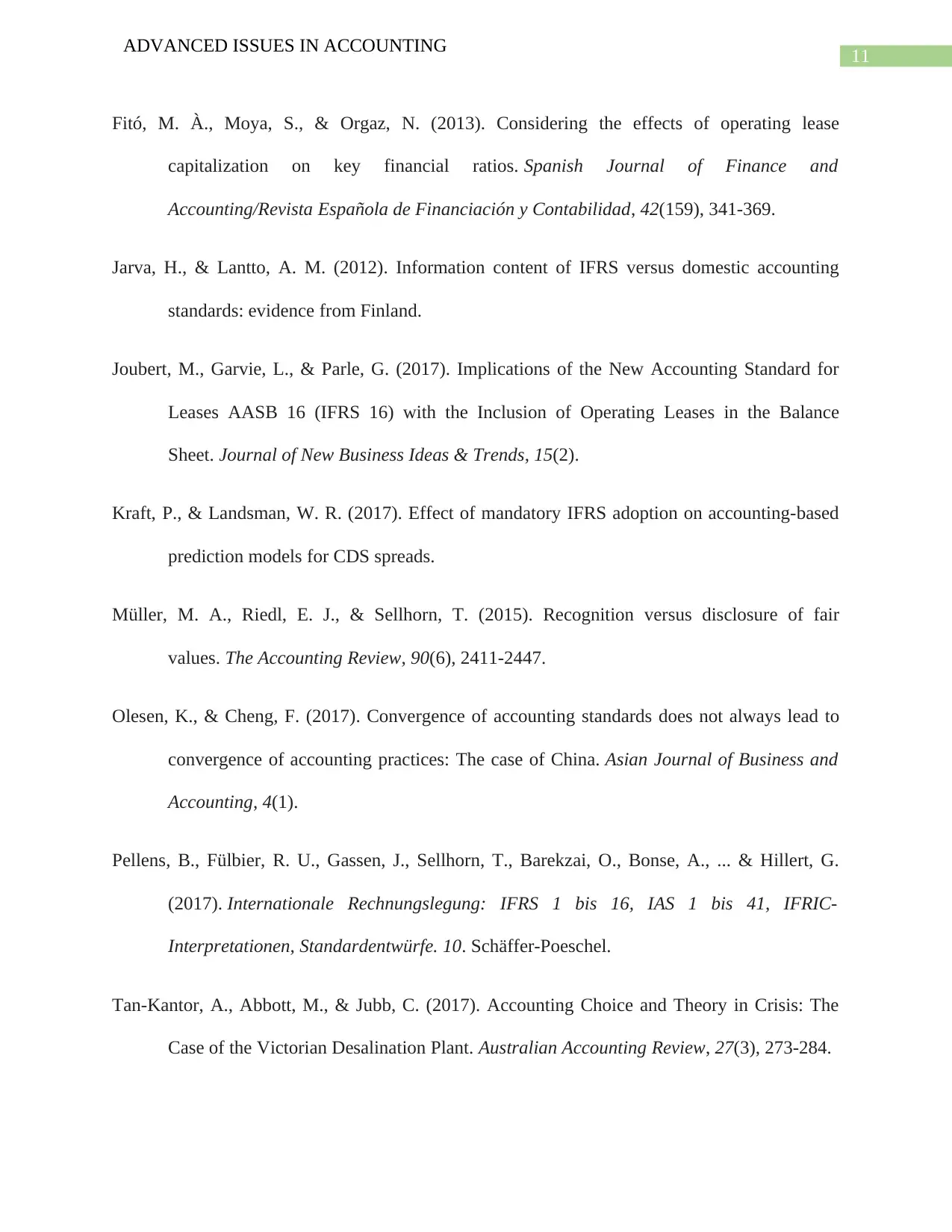
11
ADVANCED ISSUES IN ACCOUNTING
Fitó, M. À., Moya, S., & Orgaz, N. (2013). Considering the effects of operating lease
capitalization on key financial ratios. Spanish Journal of Finance and
Accounting/Revista Española de Financiación y Contabilidad, 42(159), 341-369.
Jarva, H., & Lantto, A. M. (2012). Information content of IFRS versus domestic accounting
standards: evidence from Finland.
Joubert, M., Garvie, L., & Parle, G. (2017). Implications of the New Accounting Standard for
Leases AASB 16 (IFRS 16) with the Inclusion of Operating Leases in the Balance
Sheet. Journal of New Business Ideas & Trends, 15(2).
Kraft, P., & Landsman, W. R. (2017). Effect of mandatory IFRS adoption on accounting-based
prediction models for CDS spreads.
Müller, M. A., Riedl, E. J., & Sellhorn, T. (2015). Recognition versus disclosure of fair
values. The Accounting Review, 90(6), 2411-2447.
Olesen, K., & Cheng, F. (2017). Convergence of accounting standards does not always lead to
convergence of accounting practices: The case of China. Asian Journal of Business and
Accounting, 4(1).
Pellens, B., Fülbier, R. U., Gassen, J., Sellhorn, T., Barekzai, O., Bonse, A., ... & Hillert, G.
(2017). Internationale Rechnungslegung: IFRS 1 bis 16, IAS 1 bis 41, IFRIC-
Interpretationen, Standardentwürfe. 10. Schäffer-Poeschel.
Tan‐Kantor, A., Abbott, M., & Jubb, C. (2017). Accounting Choice and Theory in Crisis: The
Case of the Victorian Desalination Plant. Australian Accounting Review, 27(3), 273-284.
ADVANCED ISSUES IN ACCOUNTING
Fitó, M. À., Moya, S., & Orgaz, N. (2013). Considering the effects of operating lease
capitalization on key financial ratios. Spanish Journal of Finance and
Accounting/Revista Española de Financiación y Contabilidad, 42(159), 341-369.
Jarva, H., & Lantto, A. M. (2012). Information content of IFRS versus domestic accounting
standards: evidence from Finland.
Joubert, M., Garvie, L., & Parle, G. (2017). Implications of the New Accounting Standard for
Leases AASB 16 (IFRS 16) with the Inclusion of Operating Leases in the Balance
Sheet. Journal of New Business Ideas & Trends, 15(2).
Kraft, P., & Landsman, W. R. (2017). Effect of mandatory IFRS adoption on accounting-based
prediction models for CDS spreads.
Müller, M. A., Riedl, E. J., & Sellhorn, T. (2015). Recognition versus disclosure of fair
values. The Accounting Review, 90(6), 2411-2447.
Olesen, K., & Cheng, F. (2017). Convergence of accounting standards does not always lead to
convergence of accounting practices: The case of China. Asian Journal of Business and
Accounting, 4(1).
Pellens, B., Fülbier, R. U., Gassen, J., Sellhorn, T., Barekzai, O., Bonse, A., ... & Hillert, G.
(2017). Internationale Rechnungslegung: IFRS 1 bis 16, IAS 1 bis 41, IFRIC-
Interpretationen, Standardentwürfe. 10. Schäffer-Poeschel.
Tan‐Kantor, A., Abbott, M., & Jubb, C. (2017). Accounting Choice and Theory in Crisis: The
Case of the Victorian Desalination Plant. Australian Accounting Review, 27(3), 273-284.
⊘ This is a preview!⊘
Do you want full access?
Subscribe today to unlock all pages.

Trusted by 1+ million students worldwide
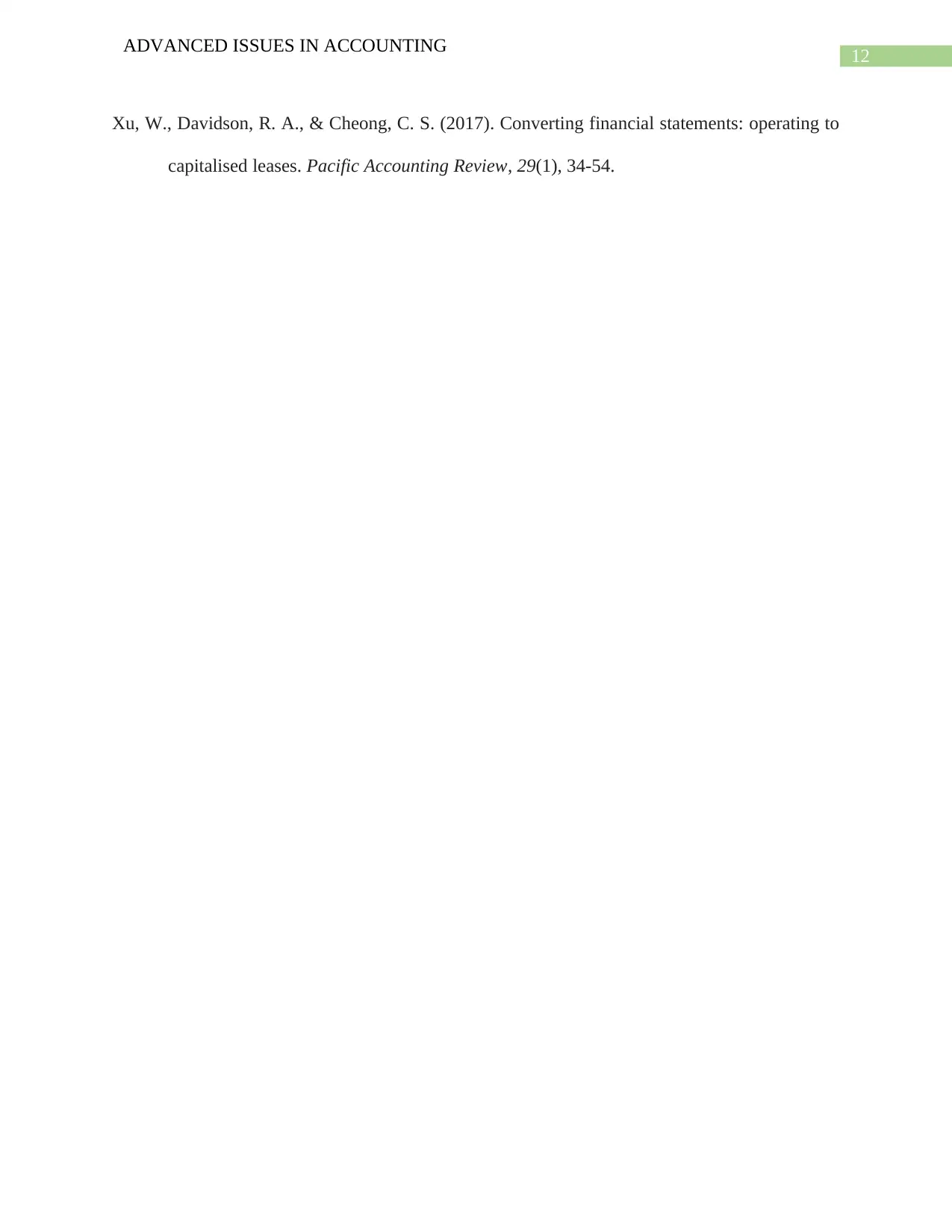
12
ADVANCED ISSUES IN ACCOUNTING
Xu, W., Davidson, R. A., & Cheong, C. S. (2017). Converting financial statements: operating to
capitalised leases. Pacific Accounting Review, 29(1), 34-54.
ADVANCED ISSUES IN ACCOUNTING
Xu, W., Davidson, R. A., & Cheong, C. S. (2017). Converting financial statements: operating to
capitalised leases. Pacific Accounting Review, 29(1), 34-54.
1 out of 13
Related Documents
Your All-in-One AI-Powered Toolkit for Academic Success.
+13062052269
info@desklib.com
Available 24*7 on WhatsApp / Email
![[object Object]](/_next/static/media/star-bottom.7253800d.svg)
Unlock your academic potential
© 2024 | Zucol Services PVT LTD | All rights reserved.





